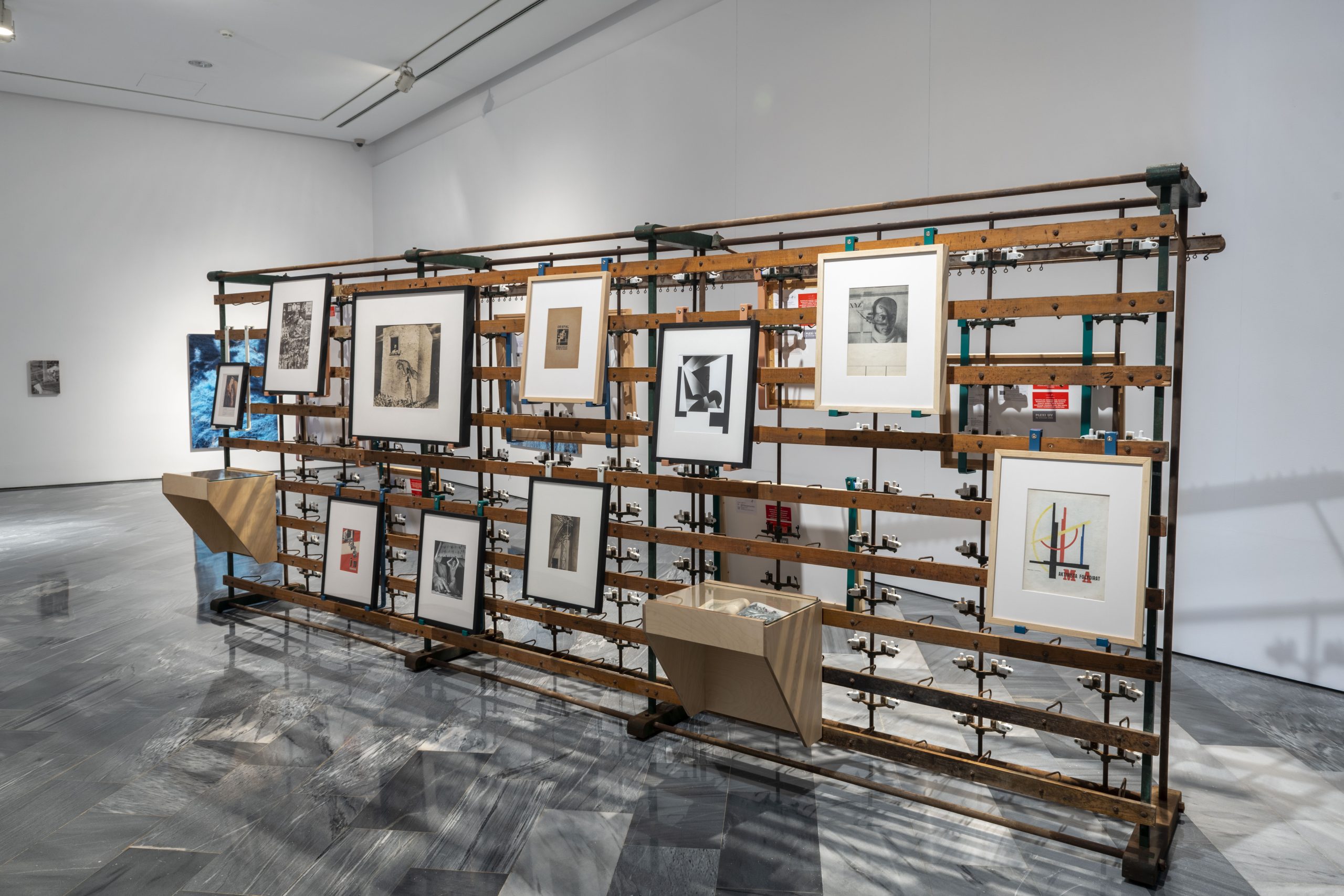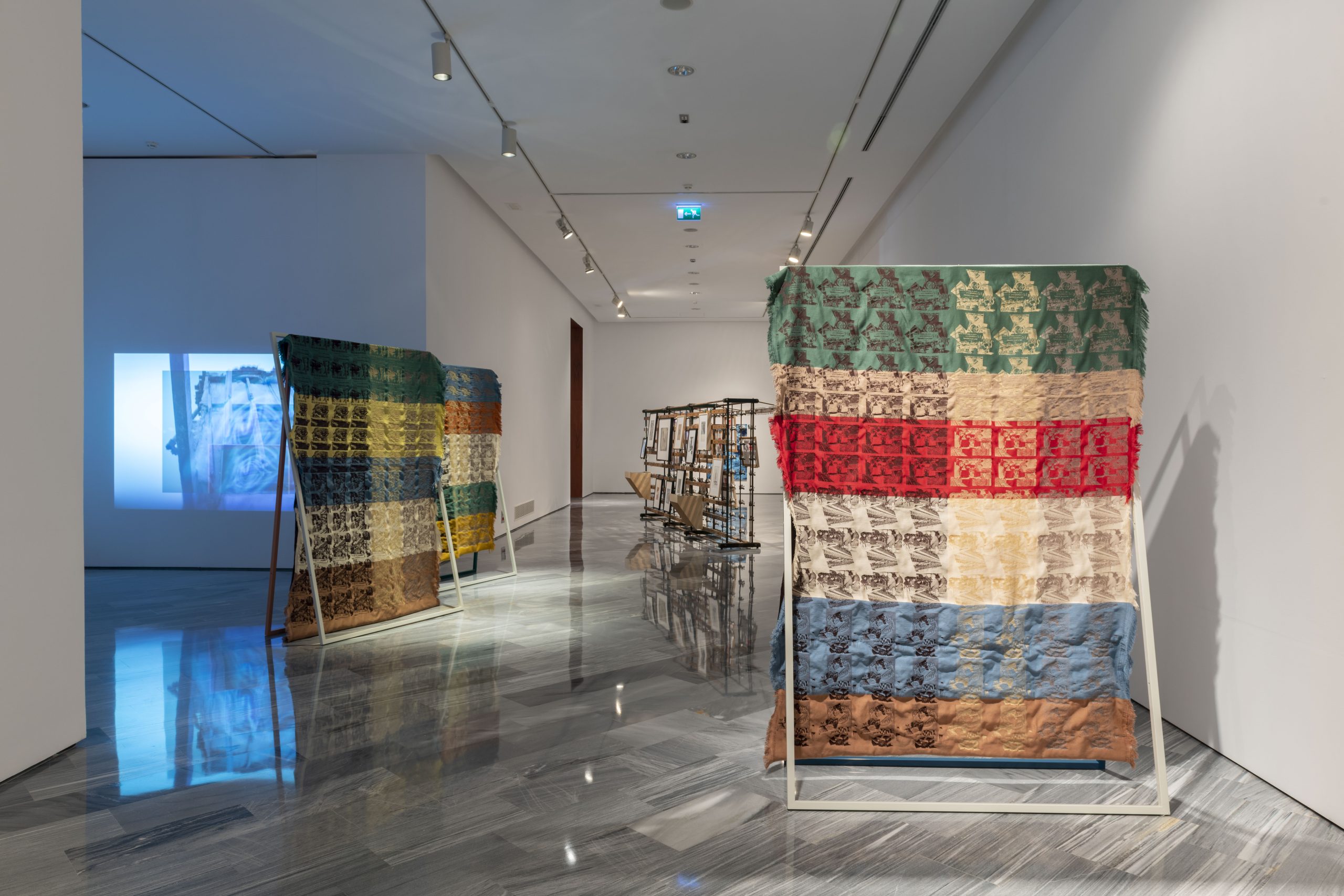Lorenzo Sandoval’s Shadow Writing (Fábrica Colectiva) (2019) is a large-scale installation that consists of three elements: a 34-minute video, a display of three Jacquard-loom textiles, and a presentation of artworks from the Institut Valencià d’Art Modern’s (IVAM) historical avant-garde photomontage collection, mounted and displayed on a coning machine.[1] The artist presents these compositions as three interrelated, yet autonomous ‘devices’ that mimic the complex structure of its parent project Shadow Writing, a long-term multi-chapter research project focused on cultural practices that are absent or underrecognised in the global canon of art history. In order to understand the artist’s use of the term ‘device’, it is useful to unpack Michel Foucault’s definition of the ‘apparatus’:
‘What I’m trying to pick out with this term is, firstly, a thoroughly heterogeneous ensemble consisting of discourses, institutions, architectural forms, regulatory decisions, laws, administrative measures, scientific statements, philosophical, moral and philanthropic propositions – in short, the said as much as the unsaid. Such are the elements of the apparatus. The apparatus itself is the network that can be established between these elements…’[2]
The network between elements that Foucault alludes to in this definition speaks directly to the organisation of Shadow Writing (Fábrica Colectiva), both as an installation and within its individual elements. These elements can operate as autonomous works and yet, sustain the idea of a system of relations in how discursive elements are inscribed in the exhibition design. The constituent parts are respectively titled Para toda clase [For all classes], Fábrica colectiva[Collective Factory] and Colección sobre colección [Collection on Collection].[3]This essay expands on one of these iterations: the moving image work and sound piece, Fábrica Colectiva.
Lorenzo Sandoval, ‘Shadow Writing (Fábrica Colectiva)’, 2019. Installation view from ‘The Achievement Society’ (2019) at Institut Valencià d’Art Modern, curated by Sandra Moros. Courtesy the artist, Lehmann + Silva Gallery and IVAM-Institut Valencià d’Art Modern. Photography: Juan García
The video Fábrica Colectiva uses montage – the layering and combining of images, voices, narratives and archives – as a methodology for creating open, permeable narrations that might add missing histories and reformulate existing ones at the core of an institutional complex. Composed of simultaneous images that Sandoval combines on different planes and fields, the editing process brings to mind the work of Harun Farocki and his trilogy Eye / Machine (2001–2003). Its circular structure opens with a view of the Spanish town of Alcoy, seen from the surrounding mountains in the early hours of the day, and ends with a voice narration by sunset. By coupling the temporality of the video with the passing of an eight-hour work day, the video recalls Walter Ruttmann’s film Berlin: Symphony of a Metropolis (1927), in which the director documents the mechanical rhythms emanating from Berlin’s industries by way of reflecting on the association of progress with modernity in the early 20th century. Sandoval’s narrative coincides partially with this period; however, in his video progress has been gradually abandoned and transformed by deindustrialisation, its modern ideals reconverted into ruins and factory spaces turned into nightclubs. Mechanical sounds are replicated in the guise of ‘máquina music’, a genre of techno music that was widespread at the end of the 1980s and early 90s in Spain.
Sound is at the core of the video’s structure, blurring its temporal linearity. Developed in collaboration with the artist Pedro André into three differentiated, yet interwoven sections, it involves several narrators and various sounds culled from different archives and field recordings, including the sound of the Jacquard loom machine that Sandoval used to produce the fabrics shown in the exhibition. He recorded the production process and later replayed it inside an abandoned factory, rerecording their resonance up to seven times. The multiple echoes produced in the space hark back to the decadence of industrial structures – abandoned by machines and by the bodies and voices that inhabited it – and function as a kind of psychophony, or, in the words of the artist, ‘a sonic cast of the factory’. Sandoval also introduces sampled rhythms from a 1914 song composed by Camilo Pérez Monllor to celebrate Alcoy’s annual Moors and Christians festival, which recall the sounds of machines in the city. He reminds us that the ‘máquina music’ that fuelled the so-called Ruta Destroy (Valencia’s late-80s, early-90s rave scene, more popularly known as Ruta del Bakalao), transcended the space of factories and workshops, permeating the wider society of Alcoy.
Let us return to Foucault’s definition of the apparatus, read through the Italian philosopher Giorgio Agamben:
‘b. The apparatus always has a concrete strategic function and is always located in a power relation.
c. As such, it appears at the intersection of power relations and relations of knowledge.’[4]
In Fábrica Colectiva, Sandoval brings these asymmetries into question by casting light on the introduction of certain subjectivities at the exclusion of others into institutions, particularly the museum, as well as problematising the materiality of cultural production and its inclusion in archives and collections. As images of the storerooms at IVAM, where the film was first shown, appear, one narrator notes:
‘The museum must conceive itself from a decentred logic, outside its own axis. In that way, it will be able to conceive a museum that incorporates diverse narrations, necessarily incomplete and always dynamic, open to difference. The untold and the un-included afford us future narrations, the glorious unfolding of difference. The question then is, which narratives are missing?’
Composed of different quotes and citations, the script also follows the logic of commoning and montage employed by the artist in the video editing. At the heart of this textual composition, the narrators seem to ask, how can we include those voices excluded from official memories, identities and knowledge? Can archives and collections continue to employ the same knowledge structures and logics of accumulation?
Sandoval’s video examines processes of collectivisation in factories during the Spanish Civil War in Alcoy. Having been granted access to IVAM’s collections, it narrates a concern curators and conservators often express regarding the museum’s collections. In spite of their unique collection of the historical avant-gardes, of works that engage with the aesthetics of the industrial age and its modes of production, works by anarchist artists are notably absent, with the exception of a couple issues of the journals Orto and Estudios in the museum’s documentation centre. Considering the traction of anarchist and worker’s movements during the Civil War and the important role they played in resisting the Spanish military dictatorship, Sandoval points to this relevant historical erasure.
In the exhibition, a coning machine from Alcoy’s municipal collections supports the display of a co-curated selection of over twenty works from the collection – mostly photographs, photomontages or posters from the historical avant-gardes, the majority of which are also included in the video. In both formats, Sandoval superimposes elements that create a complex discursive structure predicated on the combination of ideological and artistic propositions present in IVAM’s collection. Returning to one of the narrators:
‘The museum has to become a narrative machine for everybody, an archive of the commons, a form of editable story. The museum should not be a national property, but a universal resource. It is crucial that artworks be understood like documents in a library, along with publications, prints, posters, photographs and other text and sound materials, which people can access and use to arm multiple narratives and to generate porous belongings.’
Sandoval blends the concept of the collection with that of the archive, speculating on an alternative approach rooted in practices of the commons. He derives inspiration from the work of Manuel Borja-Villel, the current director of the Museo Nacional Centro de Arte Reina Sofía (MNCARS) in Madrid.[5] Borja-Villel has expressed the importance of practicing the commons against the logics of neoliberal accumulation in MNCARS’ collection by facilitating access to the artworks. In his recent book, Campos Magnéticos he writes, ‘the accounts and experiences generated by an artwork go beyond custody or possession. In other words, these outcomes belong to everyone, to the commons.’[6]
In the video, Sandoval brings together little known materials borrowed from Alcoy’s Municipal Archive, audio excerpts from the personal archive of Salomé Moltó – an expert in the Libertarian movement in Alcoy and member of the National Confederation of Labour (CNT) – and recordings from Alan Lomax’s archives (1915–2002), an American ethnomusicologist who travelled through Spain in the 1950s to record folk music on a portable Ampex recorder. Lomax’s recordings enable us to retain the memory of those voices that were silenced by the homogenising cultural apparatus of Spain’s military dictatorship for their diverse cultural expressions. Sandoval deliberately recovers this political potential.
In the voiceover, we also hear excerpts from two works by the Russian anarchist thinker Piotr Kropotkin (1842–1921), The Conquest of Bread (1892) and Anarchist Morality (1891), narrated by the artist Eli Cortiñas. In these excerpts we hear a rejoinder to Social Darwinism, which advocates greater individualism, competition and exploitative practices, in what is a clear link between the logics of capitalist accumulation and evolution. In contrast, Kropotkin believed that all beings on Earth, humans and animal, collaborated with each other. Kropotkin’s theory of mutual aid directly informs how the artist critically frames the writing practices weaved by Andean societies in the video and in the textiles shown in the exhibition. Referencing the work of Silvia Rivera Cusicanqui, Sandoval expands on previous research into the relationship between textiles practices and the origin of computation in Shadow Writing (Algoritmo/Quipu) (2017), by focusing on textiles woven by societies that have opted for forms of organisation centred on cooperation.
Sandoval’s use of the device and critical engagement with the apparatus of the archive, the collection and, ultimately, the museum, forces us to consider new modes of production and representation that can only be implemented by questioning the erasures that shape the systems in which we are all caught up.
Credits
Fábrica Colectiva, 2019
HD video, sound, colour, 34 min
Camera, realisation, montage: Lorenzo Sandoval
Sound composition: Pedro André and Lorenzo Sandoval
Voice Over: Andrea Cagua, Eli Cortiñas
Narrator: Salomé Moltó
Collectivist: Daniel Llin
Text: Sandra Moros (with gratitude to the artist and the editor for their support in writing this piece)
Commissioned by IVAM for the exhibition ‘The Achievement Society’ (2019), curated by Sandra Moros.
On view: 20 Oct – 27 Oct 2020


